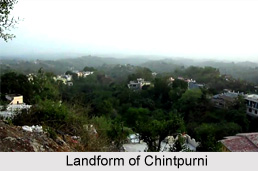 Chintpurni is a major pilgrimage centre in Himachal Pradesh. Chintpurni shakti peeth (Chhinnamastika shakti peeth) is located in Una district of Himachal Pradesh.
Chintpurni is a major pilgrimage centre in Himachal Pradesh. Chintpurni shakti peeth (Chhinnamastika shakti peeth) is located in Una district of Himachal Pradesh.
Location of Chintpurni
Chintpurni is situated at the altitude of 940 metres and is part of Una district, Himachal Pradesh. The temple is situated on one of the highest peaks of the Sola Singhi range of hills. It is about 3 km west of Bharwain which is located on the Hoshiarpur - Dharmashala road. This road is part of the State Highway network and is normally kept in good shape throughout the year. Chintpurni is surrounded by the western Himalaya in the north and east in the smaller Shiwalik (or Shivalik) range bordering the state of Punjab. Chintpurni Shakti Peeth is dedicated to the temple of Chinnamastika Devi or Chinnamasta Devi. Chhinnamasta or Chinnamastika temple is one of the 7 major and 51 total Shakti Peethas.
 History of Chintpurni
History of Chintpurni
When Lord Vishnu cut up the body of Sati into 51 pieces so that Lord Shiva or Mahadeva would calm down and stop his Tandava, the pieces were scattered over various places in the Indian subcontinent. It is believed that parts of Sati"s Forehead fell at this place and is thus considered one of the most important of the 51 Shakti Peethas. The goddess resident in Chintpurni is also known by the name of Chhinnamastika. According to Markandeya Purana, goddess Chandi defeated the demons after a fierce battle but two of her yogini emanations (Jaya and Vijaya) were still thirsty for more blood. Goddess Chandi cut off her own head to quench Jaya and Vijaya"s thirst for more blood. She is usually shown holding her own severed head in her hand, drinking one stream of blood spurting from the arteries in her neck, while at her side are two naked yoginis, each of whom drinks another stream of blood. Chhinnamasta, the headless goddess, is the Great Cosmic Power who helps the sincere and devoted yogi to dissolve his or her mind, including all the preconceived ideas, attachments and habits into the Pure Divine Consciousness. Cutting off the head suggests the separation of the mind from the body that is the freedom of the consciousness from the material confines of the physical body. According to Puranic traditions, Chhinnamastika Devi will be protected by Shiva - Rudra Mahadev in the four directions. There are four Shiva temples - Kaleshwar Mahadev in the east, Narayhana Mahadev in the west, Muchkund Mahadev in the north and Shiva Bari in the south - which are nearly equidistant from Chintpurni. This also confirms Chintpurni as the abode of Chhinnamastika Devi. Chinna Mastika Devi is a divine embodiment of self-sacrifice and there by the Chintpurni shri is considered as a Shakti Peetha. The mythology of Daksha yaga and Sati`s self immolation is the mythology liked to the Shakti Peethas.



















